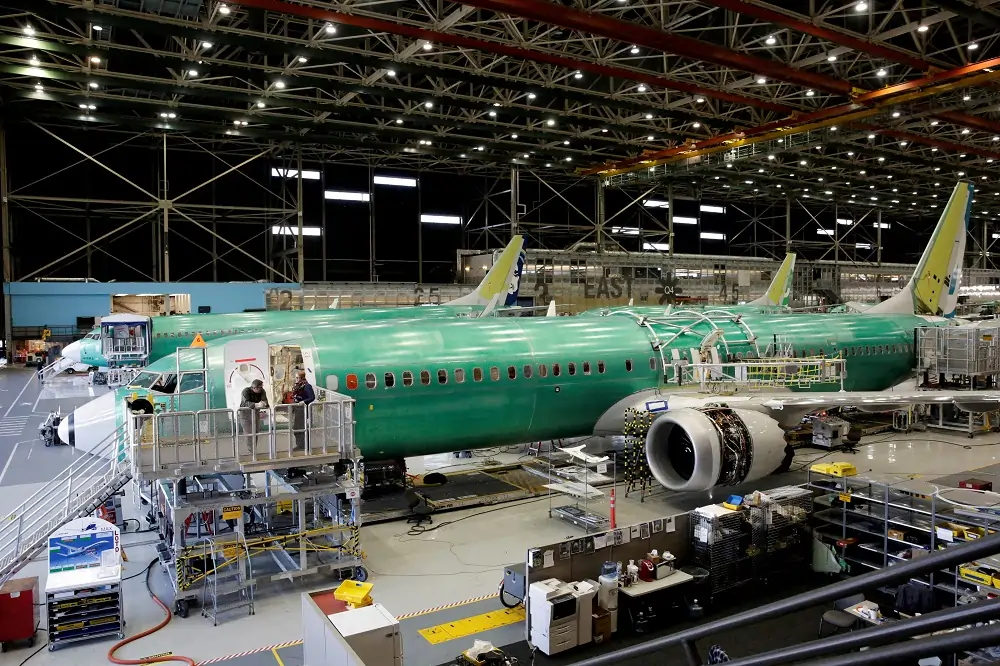
Boeing execs stand by 2025-26 financial guidance; near-term focus is safety
By Valerie Insinna and Abhijith Ganapavaram
(Reuters) -Boeing Co executives on Wednesday stood by their financial targets for 2025-2026 and said the company is working hard to regain the confidence of regulators and customers after a mid-air cabin-panel blowout on a 737 MAX aircraft, lifting its shares 6.3%.
As expected, CEO Dave Calhoun did not offer a financial or delivery forecast for 2024, stating that the company must focus on delivering quality airplanes.
However, Chief Financial Officer Brian West said during an earnings call the company remains confident it will reach free cash flow of about $10 billion by 2025-2026, and 737 production of 50 per month as outlined in November 2022.
West added that Boeing expects a steady year of cash flow based on 737 production at its current rate of 38 jets per month, as well as 737 and 787 deliveries from its inventory.
The U.S. Federal Aviation Administration (FAA) barred the company from lifting production earlier this month, while increasing its oversight. West said it would keep its suppliers producing at the higher rates laid out in its master schedule, which call for a ramp up to 42 per month in February.
“If that means we have to hold more inventory, so be it,” West said.
The planemaker reported a narrower-than-expected quarterly loss as well as better-than-expected revenue and free cash flow, though investors are more likely to focus on the company’s expectations as it navigates the current crisis.
The accident involving an Alaska Airlines-operated MAX 9 jet this month has turned into a full-blown safety and reputational crisis, potentially leading to slower jet production and a loss of more narrowbody market share to Airbus.
Of the 171 MAX 9s grounded by the FAA earlier this month, 129 have returned to service, Calhoun said.
Calhoun told CNBC in an earlier interview on Wednesday he was convinced the door plug issue was completely under control.
He declined to comment on media reports that Boeing did not replace the bolts after removing the door plug from the Alaska Airlines jet that suffered the blowout, citing an ongoing National Transportation Safety Board investigation, but said it would be a “miss” if the NTSB finds the bolts were not installed.
Robert Stallard of Vertical Research Partners said in a note to investors that the full ramifications of MAX safety issues have yet to be seen.
The 787 production rate was at five per month, Boeing said, adding that it had also resumed 777X production during the fourth quarter.
Jefferies projects the company could amass $5.5 billion in free cash flow in 2024 if it delivers 545 737s and 84 787s during the year, but that projection assumes Boeing is able to ramp 737 production to 42 jets per month in the second half.
‘MORE WORK TO DO’
Increasing production of 737 MAX jets is crucial to Boeing’s recovery from a separate safety crisis arising from two fatal crashes in 2018 and 2019 and the subsequent aerospace slump that followed due to the COVID-19 pandemic.
“We’ve taken significant steps over the last several years to strengthen our safety and quality processes, but this (Alaska Airlines) accident makes it absolutely clear that we have more work to do,” Calhoun said.
He also pointed to an announcement this month that Boeing would add quality inspections for the 737 MAX and deploy a team to supplier Spirit AeroSystems, which makes and installs the plug door involved in the incident.
For the fourth quarter, Boeing reported an adjusted per-share loss of 47 cents, narrower than analysts’ estimates of a loss of 78 cents, as per LSEG data.
The company’s ailing defense business logged $139 million in losses on fixed-price development programs.
Revenue rose 10% to $22.02 billion, above expectations of about $21.1 billion.
Boeing did not provide an update to its 2025-26 cash flow and MAX production forecast amid lingering industry doubts on whether the planemaker will be able to achieve those targets after the FAA’s unprecedented decision.
During its investor day in November 2022, Boeing projected free cash flow of about $10 billion by 2025-2026 and 737 production of 50 per month.
But it reported 2023 free cash flow of $4.43 billion, achieving its target of $3 billion to $5 billion for the year.
(Reporting by Abhijith Ganapavaram in Bengaluru and Valerie Insinna in Washington, DC; Editing by Anil D’Silva, David Ljunggren and Nick Zieminski)


